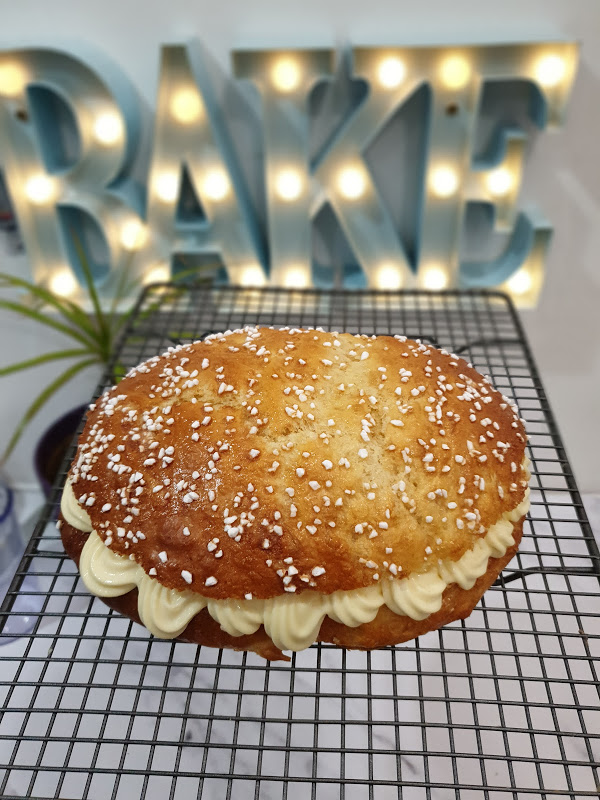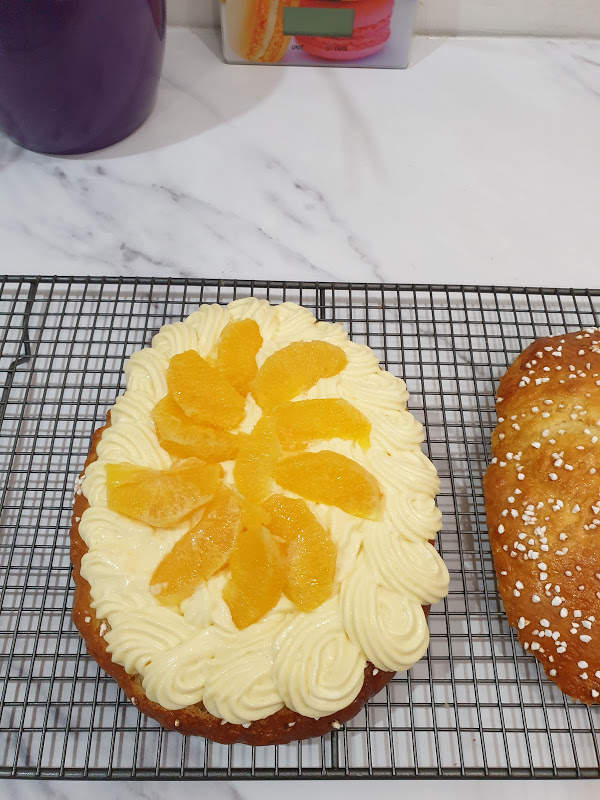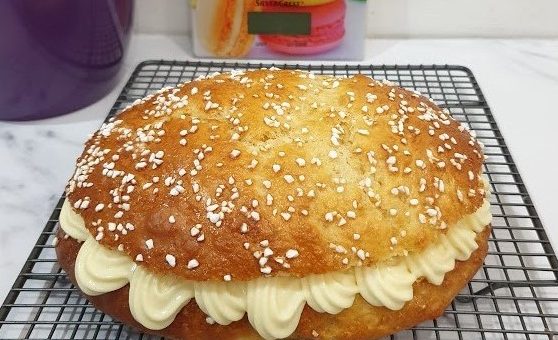I came across the Tarte Tropézienne on Le Meilleur Pâtissier and was instantly intrigued. For a start, it’s not a tart. Shock horror! And secondly, it originates from St Tropez (it seems so obvious now!). Much like last week’s Spanish kings cake, it straddles the realms of bread and cake, with its brioche dough and sweetened accessories. The round brioche is sliced in half and filled with an orange-flavoured cream, which can be anything from crème pat to crème diplomat, or in my case, the enigmatic crème madame. It is then topped with pearl sugar and icing sugar.
Crème what, now?
Not another crème you cry! I feel your pain. One day I’ll write a crème dictionary, but for now, here is a useful link to a French cheat sheet.
First, a brief summary of the crème madame family:
| French | English | Composition |
| Crème patissière | Crème patissiere/pastry cream | Egg yolks, sugar, flour, milk |
| Crème diplomate | Crème dilopmat/diplomat cream | Crème patisserie with gelatine and whipped cream |
| Crème madame | Crème madame | Crème diplomat without the gelatine. |
As you can see, crème madame doesn’t contain gelatine like its sister cream, the crème diplomat, making it more unstable and less set. It sounded potentially dangerous, and we could all do with some excitement in our lives these days, so I decided to go brave this option anyway. The cream was definitely more runny than a crème diplomat (see seeping cream in photo), but the lines from my star nozzle remained visible. To be honest, the cake didn’t last long anyway so it wasn’t an issue.

The history of the Tarte Tropézienne
The Tarte Tropézienne was invented by Alexandre Micka, a Polish immigrant who founded restaurant of the same name in the heart of Saint Tropez. The cake was inspired by one of his grandmother’s recipes and the reason there are so many interpretations of the cream is because his recipe was and remains a very closely-guarded secret.
The brioche-filled cake was popularised by Brigitte Bardot, who tasted it for the first time while filming “And God Created Woman” nearby. She was completely won over by the cake and suggested it be named La Tarte Tropézienne.
Even today, the recipe remains tightly under wraps and has only been revealed to three lucky people.
Translation
I came across a few interesting terms during translation.
‘Sucre en grains’ is literally granulated sugar, but here refers to the coarser decoration used to top the brioche, i.e. pearl sugar.
Thestand mixer needed to be ‘muni du crochet’, fitted with a crochet or hook, which meaning the dough hook attachment.
‘découpez la en deux dans l’épaisseur’, means to cut in half in the thickness, which actually refers to slicing it in half horizontally (i.e. so you can fill with cream). I considered using ‘crosswise’, but I haven’t come across this very often and went with horizontally, which explains it clearly enough.
A royal cock-up
‘Dans un cul de poule, faites blanchir les oeufs avec le sucre en poudre’.
I had some fun with this sentence. When I sampled it in machine translation the result was this gem:

“In a hen’s arse, blanch the eggs with the caster sugar.”
And when I tried again more recently, the following option was suggested:
“In a bottom of hen, make bleach eggs with the powdered sugar.”
I assure you, no hens were harmed in the making of my tarte tropézienne! It’s a relief to see that human translators are still relevant, if not vital! Obviously neither of these options are particularly appetising, or even correct. A ‘cul de poule’ simply refers to a mixing bowl. I’ve seen ‘Faites blancher les oeufs avec le sucre’ cause issues in a few literal translations, with ‘blanchir’ being translated as blanch. The alternative of ‘make bleach’ isn’t much of an improvement. The correct translation would be ‘beat the eggs with the sugar until pale’, with ‘faire blancher’ meaning to make pale.

Conclusion
I decided to add some fresh fruit to my tarte tropézienne in the form of fresh orange, and in the process learnt all about segmenting, or supreming, as it’s referred to by the pros. This basically means cutting into segments, removing the skin, pith, membranes and seeds so you are left with the soft smooth texture of the fruit.
The end result is akin to a Victoria sandwich, with brioche replacing the sponge and a fancier cream interior. A refreshing afternoon snack enjoyed with a cup of tea.
That’s all for now, but for something similar, see the Spanish kings cake, which is a sweet brioche-like cake.



